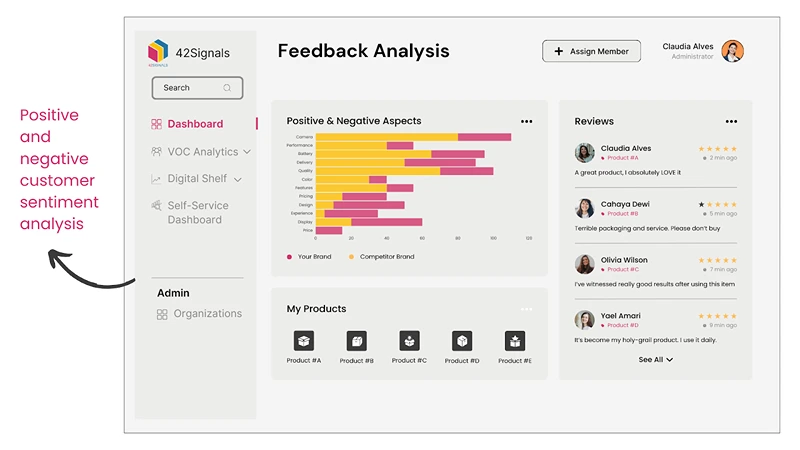Consider this: You run an online store. Remaining competitive means you are continuously monitoring competitor prices, stock counts, and reviews. Your staff manually aggregates this ecommerce data, but it becomes irrelevant in less than a day. This is annoying, ineffective, and crippling for your business.
Now, imagine if you could automate the entire process. Rather than fetching data from multiple websites manually, an ecommerce API directly integrates into your system and provides perpetual updates regarding competitors in real-time.
You eliminate all guesswork—no more outdated insights. improvement to pricing, marketing, inventory management, and advertising becomes an effortless process.
In this article, we’ll explore how ecommerce APIs help businesses automate data collection to streamline the decision-making process and provide an edge over competitors in the ever-changing marketplace.
What is an Ecommerce API?

An ecommerce API offers capabilities for different programs to communicate with each other. This allows for software systems to interact. Think of it as a digital bridge that connects your operations to the rest of the world like online marketplaces and competitor sites so that you can fetch, collect, and analyze pertinent data without any manual effort.
These APIs can retrieve various types of data, including:
- Pricing Data – Receive competitor dynamic pricing feeds to adjust your pricing strategically
- Stock Availability –Keep track of inventory challenges faced by competitors so you can take advantage of market gaps.
- Product Descriptions & Specifications – Make sure your product listings are as competitive and detailed as possible.
- Customer Reviews & Ratings – Examine external consumer sentiments to find gaps in the internal systems interfaces like pricing engines, inventory management systems, analytics, ecommerce websites, online shopping platforms, and competitors’ data.
For instance, if your company needs to monitor prices from competitors on Amazon, Walmart, or eBay, an ecommerce API can retrieve the current pricing information, stock levels, listings, and promotional offers without you having to visit the websites individually. This information can be utilized to modify pricing policies, enhance product listing strategies, and boost overall market competitiveness.
Why Ecommerce APIs are Essential for Online Businesses
1. Automating Data Collection
Tracking changes to a product’s information is a great ordeal that ecommerce businesses face. Manually following price changes and availability for several platforms becomes time-consuming and impossible to maintain as your business grows.
An ecommerce API offers a fully automated service where you receive well-organized and updated data without any effort on your end. With the ease of data fetch automation, businesses can respond to changes in the market, fine-tune their pricing, and remain ahead of the competition.
2. Competitive Intelligence Made Easy
Knowing your competition and staying on top of them helps in surviving and thriving in the ecommerce domain. A competitor data API allows businesses to monitor competitor products, sales, and overall stock levels.
For instance, should a competitor choose to discount a hot-selling item, you can respond to undercut their price instantly. Such agility and responsiveness are made possible by timely and accurate data access enabled through ecommerce APIs.
3. Enhancing Ecommerce Analytics
Optimizing your ecommerce operations goes beyond amassing terabytes worth of data; it demands careful consideration of how that data is utilized. Insights can be gathered from structured data provided through the use of APIs.
By integrating APIs with analytics tools, businesses can:
- Map and refine pricing strategy by implementing dynamic pricing.
- Study the product demand across various marketplaces.
- Optimize inventory management based on real-time stock data.
Analyzing consumer behaviors, one study concluded that 60% of consumers visit several websites before finalizing a purchase. When equipped with an understanding of where their products are listed in comparison to the competition concerning pricing, businesses can enhance their pricing and marketing plans.
4. Streamlining Digital Shelf Analytics

As defined, the digital shelf is the online representation of products at digital retailers. Elements such as visibility, price, customer review rating, stock, and seasonality all impact the sales velocity of a product.
An ecommerce API helps brands track and optimize their digital shelf by providing data on:
- How competitors position their products.
- The impact of price changes on conversions.
- The effectiveness of promotional campaigns.
With the help of digital shelf analytics, brands can optimize their sales and brand recognition through strategic planning.
What Are The Types of Ecommerce APIs?
Different ecommerce functions available constitute the different types of ecommerce APIs, each type serving a particular function. Knowing these classes will aid you in identifying the correct API to fit your business requirements.
- Product Data APIs – These provide current details on a product including its description, images, specifications, and any available variations. These APIs are vital for businesses because they ensure the correctness and currency of their product listings.
- Competitor Data APIs – These APIs retrieve competitor prices, promotional offers, and stock status from different online stores. They are vital for business intelligence since they help firms to adjust their pricing policies dynamically.
- Ecommerce Platform APIs – These are used to integrate with Shopify, Magento, WooCommerce, and other platforms to help automate business functions like inventory, orders, and product updates.
- Review and Sentiment Analysis APIs – These aggregate reviews and ratings from different sources, allowing businesses to analyze sentiment towards their products and enhance their offerings.

- Search and SEO APIs – These monitor keyword performance, search volume, and customer queries on ecommerce sites to assist businesses in optimizing product performance and sales.
Now, what if you got all these in one API? 42Signals does just that!
How Ecommerce API Integration Works
Ecommerce APIs serve as intermediaries between online marketplaces and the clients’ systems like ecommerce dashboards, pricing engines, and inventory management tools. Below are the actions to be taken:
1. Identify Your Data Needs
Pick an API based on the data you intend to use and what benchmarks drive your business. Set goals with consumer analysis, stock level comparison, and competitive pricing insights. These aims will help you structure the business API outline better.
2. Choose a Reliable API Provider
In your search for an API provider, focus on one that guarantees real-time, accurate data, high uptime, and reliable support. Popular providers include 42Signals, which offers competitor data APIs and analytics for ecommerce, providing businesses with valuable insights into changing markets.
3. Ensure Seamless Integration
APIs should synchronize with your current framework, be it the analytics dashboard, CRM, or pricing engine. Collaborate with your developers on the proper design to ensure effortless ecommerce API integration that allows for smooth data transfer.
4. Automate and Optimize
While setting up the API, strive to automate as much as possible. Employ dynamic pricing policies, automated stock updates, and competitor surveillance alerts to outperform the market without exerting manual labor.
5. Monitor and Scale
While APIs offer perpetual data supply, businesses require continuous supervision to validate their performance. Make alterations where necessary to retain the relevance of the supplied data and ensure it facilitates decision-making.
Use Cases of Ecommerce APIs in Business Operations
1. Price Optimization

A dynamic pricing solution offers merchants an edge in growing their online business. Through an ecommerce API, businesses can monitor competitor prices and make adjustments to their pricing in real-time.
2. Inventory Management

An out-of-stock product amounts to lost sales. Thanks to APIs, businesses can oversee stock levels on different platforms and can ensure that inventory is always available when needed.
3. Market Expansion
Expanding to new marketplaces has to be accompanied by an understanding of demand and pricing for the specific product. APIs offer profiling information about different markets which helps businesses make better moves before introducing new products or entering new regions.
4. Competitor Analysis

A competitor data API gives businesses a comprehensive view of their competitors’ activities. From analyzing product reviews to tracking discounts, APIs provide important information that can be used in marketing and pricing decisions.
How to Choose the Right Ecommerce API for Your Brand
There are various types of ecommerce APIs and not all of them are the same. When choosing an API keep in mind the following:
1. Data Accuracy and Coverage
Check the Ecommerce API, and ensure that the data they provide is accurate and obtained from different platforms. The more information offered, the better the insights.
2. Scalability
With the growth of your business, the data requirements will increase. Select an API that is capable of growing alongside your operations.
3. Integration Ease
Find an API that works with your existing software and is not too complex to integrate. The simpler its framework, the earlier you can begin to reap the benefits.
4. Compliaṣnce and Security
Check for relevant oversight and ensure the provider complies with data control frameworks and has security protocols in place to safeguard the organization’s and customers’ information.
The Future of Ecommerce APIs
The ecommerce sector is likely to require deeper ecommerce API integrations in the future. APIs are advanced now with AI and machine learning, which allows for predictive analytics, and automating smarter processes.
As reported, the ecommerce analytics industry is likely to expand by 15% during the next five years, which illustrates the growing importance of ecommerce in modern business strategy powered by ecommerce data intelligence.
Any business that utilizes ecommerce APIs will have an advantage in pricing, inventory management, business intelligence, and even competition.
Final Thoughts
An ecommerce API reshapes the online business ecosystem. The flexibility that comes with automating data collection, enhancing competitive business intelligence, and analytics intuitively improves decision-making speed.
It’s important to note that the shift from manual data collection to API automation streamlines business operations. The right tools should be leveraged so that ecommerce strategies become more proactive with data.Contact us to get started on better integrating advanced APIs into your eCommerce strategy.





